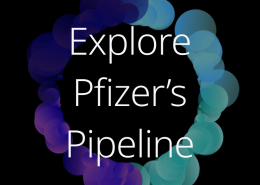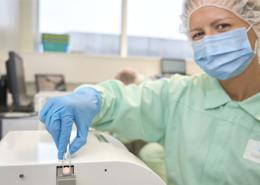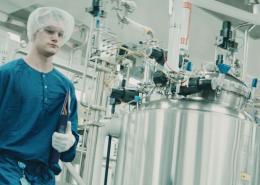PENELOPE-B Trial of IBRANCE® (palbociclib) in Early Breast Cancer Did Not Meet Primary Endpoint
NEU-ISENBURG, Germany & FRANKFURT, Germany & NEW YORK--(BUSINESS WIRE)-- The German Breast Group (GBG) and Pfizer Inc. (NYSE: PFE) today announced that the collaborative Phase 3 PENELOPE-B trial did not meet the primary endpoint of improved invasive disease-free survival (iDFS) in women with hormone receptor-positive (HR+), human epidermal growth factor-negative (HER2-) early breast cancer (eBC) who have residual invasive disease after completing neoadjuvant chemotherapy. No unexpected safety signals were observed.
This press release features multimedia. View the full release here: https://www.businesswire.com/news/home/20201009005066/en/
PENELOPE-B is a randomized, double-blind, placebo-controlled Phase 3 study comparing one year of palbociclib plus at least five years of standard adjuvant endocrine therapy to placebo plus at least five years of standard adjuvant endocrine therapy. The trial is sponsored by the GBG as part of a clinical research collaboration with Pfizer and other study groups.
“Reducing the risk of disease recurrence in patients who have residual disease after neoadjuvant chemotherapy is a complex clinical challenge,” said Professor Sibylle Loibl, Chair of GBG. “This unique trial was made possible through the collaboration and support from all the research partners involved. Despite this outcome, we believe that key learnings will emerge from the large number of biomarkers being analyzed from collected tumor tissue, which will help inform future breast cancer research.”
“This is the first randomized Phase 3 study to establish mature iDFS results for a CDK4/6 inhibitor as part of the adjuvant treatment for early breast cancer. While we are disappointed with this result, we look forward to continuing to work with our research partners to understand subgroup data and how these could inform the development of our next-generation CDK inhibitors in early breast cancer,” said Chris Boshoff, M.D., Ph.D., Chief Development Officer, Oncology, Pfizer Global Product Development. “We are proud of the transformative impact IBRANCE has had on the treatment of HR+, HER2- metastatic breast cancer - a vastly different treatment setting than early breast cancer. Our commitment to the metastatic patient community is as strong as ever as we continue to generate new data, including the most extensive body of real-world evidence for a CDK 4/6 inhibitor.”
Detailed findings from PENELOPE-B will be presented at an upcoming medical congress.
About the PENELOPE-B Study
PENELOPE-B is a randomized, double-blind, placebo-controlled Phase 3 study comparing one year of palbociclib plus at least five years of standard adjuvant endocrine therapy to placebo plus at least five years of standard adjuvant endocrine therapy in 1,250 women with HR+, HER2- eBC at high risk of recurrence who have residual invasive disease after completing neoadjuvant chemotherapy. Patients in the trial scored 3 or higher (or 2 if there were lymph node metastases at the time of surgery) on the clinical-pathologic stage – estrogen/grade (CPS-EG). The CPS-EG is a validated risk assessment tool combining: clinical stage before neoadjuvant treatment, pathological stage after neoadjuvant treatment, grading and estrogen-receptor status. The trial is sponsored by the GBG as part of a clinical research collaboration with other study groups, including ABCSG, AGO-B, ANZBCTG, BIG, CCTG, GEICAM, LACOG, IBCSG, ICORG, ISPy-2, JBCRG, KCSG, NSABP, Unicancer and Pfizer.
More than 190 clinical sites in 12 countries around the globe participated in PENELOPE-B. The study opened in November 2013 and closed recruitment on December 31, 2017.
About IBRANCE® (palbociclib) 125 mg tablets and capsules
IBRANCE is an oral inhibitor of CDKs 4 and 6,1 which are key regulators of the cell cycle that trigger cellular progression.2,3 In the U.S., IBRANCE is indicated for the treatment of adult patients with HR+, HER2- advanced or metastatic breast cancer in combination with an aromatase inhibitor as initial endocrine based therapy in postmenopausal women or in men; or with fulvestrant in patients with disease progression following endocrine therapy.
IBRANCE currently is approved in more than 95 countries and has been prescribed to nearly 340,000 patients globally. IBRANCE is not indicated for early breast cancer.
The full U.S. Prescribing Information for the IBRANCE tablets and the IBRANCE capsules can be found here and here.
IMPORTANT IBRANCE®(palbociclib) SAFETY INFORMATION FROM THE U.S. PRESCRIBING INFORMATION
Neutropenia was the most frequently reported adverse reaction in PALOMA-2 (80%) and PALOMA-3 (83%). In PALOMA-2, Grade 3 (56%) or 4 (10%) decreased neutrophil counts were reported in patients receiving IBRANCE plus letrozole. In PALOMA-3, Grade 3 (55%) or Grade 4 (11%) decreased neutrophil counts were reported in patients receiving IBRANCE plus fulvestrant. Febrile neutropenia has been reported in 1.8% of patients exposed to IBRANCE across PALOMA-2 and PALOMA-3. One death due to neutropenic sepsis was observed in PALOMA-3. Inform patients to promptly report any fever.
Monitor complete blood count prior to starting IBRANCE, at the beginning of each cycle, on Day 15 of first 2 cycles and as clinically indicated. Dose interruption, dose reduction, or delay in starting treatment cycles is recommended for patients who develop Grade 3 or 4 neutropenia.
Severe, life-threatening, or fatal interstitial lung disease (ILD) and/or pneumonitis can occur in patients treated with CDK4/6 inhibitors, including IBRANCE when taken in combination with endocrine therapy. Across clinical trials (PALOMA-1, PALOMA-2, PALOMA-3), 1.0% of IBRANCE-treated patients had ILD/pneumonitis of any grade, 0.1% had Grade 3 or 4, and no fatal cases were reported. Additional cases of ILD/pneumonitis have been observed in the post-marketing setting, with fatalities reported.
Monitor patients for pulmonary symptoms indicative of ILD/pneumonitis (e.g. hypoxia, cough, dyspnea). In patients who have new or worsening respiratory symptoms and are suspected to have developed pneumonitis, interrupt IBRANCE immediately and evaluate the patient. Permanently discontinue IBRANCE in patients with severe ILD or pneumonitis.
Based on the mechanism of action, IBRANCE can cause fetal harm. Advise females of reproductive potential to use effective contraception during IBRANCE treatment and for at least 3 weeks after the last dose. IBRANCE may impair fertility in males and has the potential to cause genotoxicity. Advise male patients to consider sperm preservation before taking IBRANCE. Advise male patients with female partners of reproductive potential to use effective contraception during IBRANCE treatment and for 3 months after the last dose. Advise females to inform their healthcare provider of a known or suspected pregnancy. Advise women not to breastfeed during IBRANCE treatment and for 3 weeks after the last dose because of the potential for serious adverse reactions in nursing infants.
The most common adverse reactions(≥10%) of any grade reported in PALOMA-2 for IBRANCE plus letrozole vs placebo plus letrozole were neutropenia (80% vs 6%), infections (60% vs 42%), leukopenia (39% vs 2%), fatigue (37% vs 28%), nausea (35% vs 26%), alopecia (33% vs 16%), stomatitis (30% vs 14%), diarrhea (26% vs 19%), anemia (24% vs 9%), rash (18% vs 12%), asthenia (17% vs 12%), thrombocytopenia (16% vs 1%), vomiting (16% vs 17%), decreased appetite (15% vs 9%), dry skin (12% vs 6%), pyrexia (12% vs 9%), and dysgeusia (10% vs 5%).
The most frequently reported Grade ≥3 adverse reactions (≥5%) in PALOMA-2 for IBRANCE plus letrozole vs placebo plus letrozole were neutropenia (66% vs 2%), leukopenia (25% vs 0%), infections (7% vs 3%), and anemia (5% vs 2%).
Lab abnormalities of any grade occurring in PALOMA-2 for IBRANCE plus letrozole vs placebo plus letrozole were decreased WBC (97% vs 25%), decreased neutrophils (95% vs 20%), anemia (78% vs 42%), decreased platelets (63% vs 14%), increased aspartate aminotransferase (52% vs 34%), and increased alanine aminotransferase (43% vs 30%).
The most common adverse reactions (≥10%) of any grade reported in PALOMA-3 for IBRANCE plus fulvestrant vs placebo plus fulvestrant were neutropenia (83% vs 4%), leukopenia (53% vs 5%), infections (47% vs 31%), fatigue (41% vs 29%), nausea (34% vs 28%), anemia (30% vs 13%), stomatitis (28% vs 13%), diarrhea (24% vs 19%), thrombocytopenia (23% vs 0%), vomiting (19% vs 15%), alopecia (18% vs 6%), rash (17% vs 6%), decreased appetite (16% vs 8%), and pyrexia (13% vs 5%).
The most frequently reported Grade ≥3 adverse reactions (≥5%) in PALOMA-3 for IBRANCE plus fulvestrant vs placebo plus fulvestrant were neutropenia (66% vs 1%) and leukopenia (31% vs 2%).
Lab abnormalities of any grade occurring in PALOMA-3 for IBRANCE plus fulvestrant vs placebo plus fulvestrant were decreased WBC (99% vs 26%), decreased neutrophils (96% vs 14%), anemia (78% vs 40%), decreased platelets (62% vs 10%), increased aspartate aminotransferase (43% vs 48%), and increased alanine aminotransferase (36% vs 34%).
Avoid concurrent use of strong CYP3A inhibitors. If patients must be administered a strong CYP3A inhibitor, reduce the IBRANCE dose to 75 mg. If the strong inhibitor is discontinued, increase the IBRANCE dose (after 3-5 half-lives of the inhibitor) to the dose used prior to the initiation of the strong CYP3A inhibitor. Grapefruit or grapefruit juice may increase plasma concentrations of IBRANCE and should be avoided. Avoid concomitant use of strong CYP3A inducers. The dose of sensitive CYP3A substrates with a narrow therapeutic index may need to be reduced as IBRANCE may increase their exposure.
For patients with severe hepatic impairment (Child-Pugh class C), the recommended dose of IBRANCE is 75 mg. The pharmacokinetics of IBRANCE have not been studied in patients requiring hemodialysis.
About the German Breast Group
The German Breast Group (GBG) is the largest academic research organization devoted to breast cancer in Germany and one of the largest worldwide with, over 50,000 patients recruited in their trials. GBG is active in all parts of breast cancer research, including surgery and niche indications such breast cancer during pregnancy. The main research activities are devoted to neoadjuvant therapy and postneoadjuvant concepts. Please visit us on www.gbg.de or follow us on twitter, https://twitter.com/GBG_Forschung.
About NSABP Foundation
The NSABP Foundation, Inc., an academic research organization, conducts industry-supported cancer research in new chemotherapeutic and targeted biologic agents for evaluation in adjuvant and neoadjuvant clinical trials in breast and colorectal cancers. The NSABP Foundation has research sites in North America and an international network made up of oncology and research professionals.
About Pfizer Oncology
At Pfizer Oncology, we are committed to advancing medicines wherever we believe we can make a meaningful difference in the lives of people living with cancer. Today, we have an industry-leading portfolio of 23 approved innovative cancer medicines and biosimilars across more than 30 indications, including breast, genitourinary, colorectal, blood and lung cancers, as well as melanoma.
Pfizer Inc.: Breakthroughs that change patients’ lives
At Pfizer, we apply science and our global resources to bring therapies to people that extend and significantly improve their lives. We strive to set the standard for quality, safety and value in the discovery, development and manufacture of health care products, including innovative medicines and vaccines. Every day, Pfizer colleagues work across developed and emerging markets to advance wellness, prevention, treatments and cures that challenge the most feared diseases of our time. Consistent with our responsibility as one of the world's premier innovative biopharmaceutical companies, we collaborate with health care providers, governments and local communities to support and expand access to reliable, affordable health care around the world. For more than 150 years, we have worked to make a difference for all who rely on us. We routinely post information that may be important to investors on our website at www.pfizer.com. In addition, to learn more, please visit us on www.pfizer.com and follow us on Twitter at @Pfizer and @Pfizer_News, LinkedIn, YouTube, and like us on Facebook at Facebook.com/Pfizer.
PFIZER DISCLOSURE NOTICE: The information contained in this release is as of October 9, 2020. Pfizer assumes no obligation to update forward-looking statements contained in this release as the result of new information or future events or developments.
This release contains forward-looking information about IBRANCE® (palbociclib) and next-generation CDK inhibitors, including their potential benefits, that involves substantial risks and uncertainties that could cause actual results to differ materially from those expressed or implied by such statements. Risks and uncertainties include, among other things, uncertainties regarding the commercial success of IBRANCE; uncertainties regarding the commercial impact of the results of the PENELOPE-B trial; the uncertainties inherent in research and development, including the ability to meet anticipated clinical endpoints, commencement and/or completion dates for our clinical trials, regulatory submission dates, regulatory approval dates and/or launch dates, as well as the possibility of unfavorable new clinical data and further analyses of existing clinical data; the risk that clinical trial data are subject to differing interpretations and assessments by regulatory authorities; whether regulatory authorities will be satisfied with the design of and results from our clinical studies; whether and when drug applications may be filed in any jurisdictions for any other potential indications for IBRANCE or in any jurisdictions for any next-generation CDK inhibitors; whether and when any such applications may be approved by regulatory authorities, which will depend on myriad factors, including making a determination as to whether the product's benefits outweigh its known risks and determination of the product's efficacy and, if approved, whether such product candidate will be commercially successful; decisions by regulatory authorities impacting labeling, manufacturing processes, safety and/or other matters that could affect the availability or commercial potential of IBRANCE or any next-generation CDK inhibitors; uncertainties regarding the impact of COVID-19 on Pfizer’s business, operations and financial results; and competitive developments.
A further description of risks and uncertainties can be found in Pfizer’s Annual Report on Form 10-K for the fiscal year ended December 31, 2019 and in its subsequent reports on Form 10-Q, including in the sections thereof captioned “Risk Factors” and “Forward-Looking Information and Factors That May Affect Future Results,” as well as in its subsequent reports on Form 8-K, all of which are filed with the U.S. Securities and Exchange Commission and available at www.sec.gov and www.pfizer.com.
1 IBRANCE® (palbociclib) Prescribing Information. New York. NY: Pfizer Inc: 2019.
2 Weinberg, RA. pRb and Control of the Cell Cycle Clock. In: Weinberg RA, ed. The Biology of Cancer. 2nd ed. New York, NY: Garland Science; 2014:275-329.
3 Sotillo E, Grana X. Escape from Cellular Quiescence. In: Enders GH, ed. Cell Cycle Deregulation in Cancer. New York, NY: Humana Press; 2010:3-22.
View source version on businesswire.com: https://www.businesswire.com/news/home/20201009005066/en/
Pfizer Media Contact:
Jessica Smith
212-733-6213
[email protected]
Pfizer Investor Contact:
Bryan Dunn
212-733-8917
[email protected]
German Breast Group Contact:
[email protected]
Source: Pfizer Inc.











